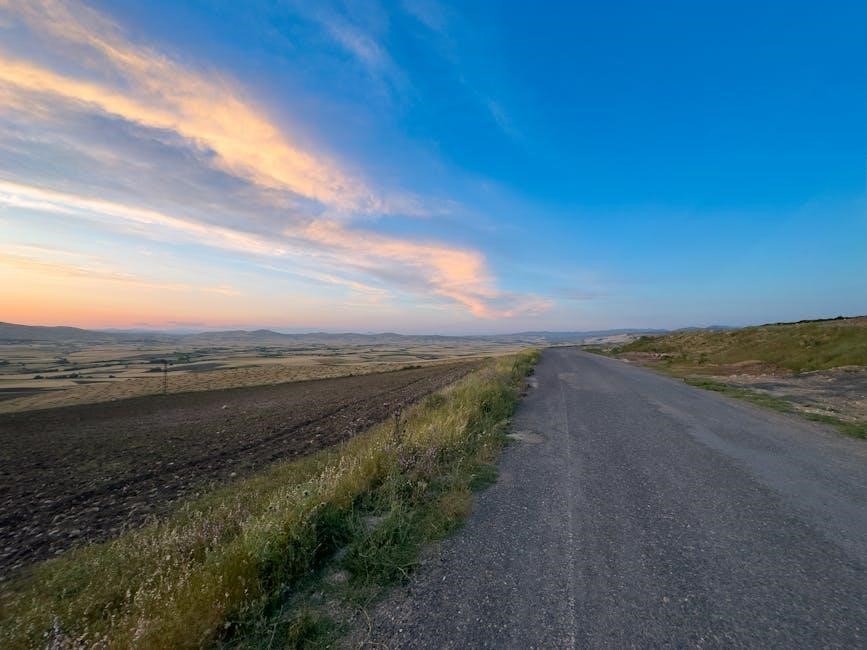
the alaska roadside angler’s guide .pdf
The Alaska Roadside Angler’s Guide is a comprehensive resource detailing prime fishing locations, techniques, and timing for anglers exploring Alaska’s accessible roadside waters, catering to both locals and visitors․
Overview of the Guide
The Alaska Roadside Angler’s Guide provides detailed insights into roadside fishing opportunities across the state․ It covers prime fishing locations, optimal timing, and effective techniques for various species․ The guide is designed for both experienced anglers and newcomers, offering practical advice on gear, regulations, and conservation practices․ By focusing on accessible waters, it helps anglers maximize their fishing experiences while respecting Alaska’s natural environment․ This comprehensive resource ensures that readers are well-prepared to explore and enjoy the state’s renowned fishing opportunities․
Importance of Roadside Fishing in Alaska
Roadside fishing in Alaska offers unparalleled accessibility to pristine waters, making it a vital part of the state’s outdoor culture․ It provides anglers of all skill levels with affordable and convenient opportunities to connect with nature․ This approachable method of fishing supports local tourism and promotes conservation by encouraging sustainable practices․ Roadside fishing also fosters a sense of community among anglers while preserving Alaska’s iconic wild fisheries for future generations․ Its significance lies in its ability to balance recreation with environmental stewardship, making it a cornerstone of Alaska’s fishing heritage․
Target Audience for the Guide
The Alaska Roadside Angler’s Guide is designed for a diverse audience, including both local residents and visiting anglers․ It caters to beginners seeking accessible fishing spots and experienced anglers looking to explore new roadside locations․ The guide is particularly useful for those interested in convenient, cost-effective fishing opportunities without the need for expensive gear or remote adventures․ It also serves as a valuable resource for families, tourists, and outdoor enthusiasts aiming to maximize their Alaska fishing experience with detailed maps and expert advice․
Popular Fishing Spots Along Alaska’s Road System
Alaska’s road system offers abundant fishing opportunities, with hotspots like the Kenai Peninsula, Matanuska-Susitna Valley, and Southcentral regions providing easy access to rivers, lakes, and streams teeming with fish․
Kenai Peninsula Fishing Locations
The Kenai Peninsula is renowned for its exceptional roadside fishing opportunities, offering access to world-class streams, rivers, and lakes․ Key spots include the Kenai River, famous for its salmon runs, and the Russian River, a hotspot for sockeye and coho salmon․ Skilak Lake and the Sterling Highway provide ample chances to catch trout and char․ These locations cater to both novice and experienced anglers, with well-maintained access points and scenic beauty․ The peninsula’s diverse fish species and productive waters make it a must-visit destination for any Alaska fishing enthusiast․
Matanuska-Susitna Valley Fishing Areas
The Matanuska-Susitna Valley offers a wealth of roadside fishing opportunities, with its vast network of lakes, streams, and rivers․ The Susitna River is a hotspot for salmon and trout, while smaller streams like Willow Creek and Montana Creek provide excellent access for anglers․ Eklutna Lake and Knik River are popular spots for both rainbow trout and Dolly Varden․ The valley’s diverse fish species and accessible locations make it an ideal destination for anglers of all skill levels, with scenic landscapes adding to the charm of the fishing experience․
Southcentral Alaska Roadside Fishing Spots
Southcentral Alaska is a paradise for roadside anglers, offering accessible fishing spots along its scenic highways․ Eklutna Lake and Knik River are prime locations for catching trout and Dolly Varden, while Eleven Mile Creek provides excellent roadside access for salmon and char․ The Glenn Highway corridor is dotted with smaller streams and lakes, perfect for a quick fishing stop․ These spots are well-suited for both beginners and experienced anglers, with abundant fish species and breathtaking views making every trip memorable․
Best Times for Roadside Fishing in Alaska
The best times for roadside fishing in Alaska vary by species and season, with peak activity during summer months for salmon, trout, and char, ideal from June to September․
Seasonal Fishing Patterns
The Alaska Roadside Angler’s Guide highlights distinct seasonal fishing patterns, with salmon runs peaking in summer, trout and char active in summer and fall, and ice fishing opportunities in winter․ Understanding these patterns is key to successful angling, as fish behavior and availability shift with water conditions and weather․ The guide provides detailed insights into when and where to target specific species, ensuring anglers maximize their chances of catching fish throughout the year․
Peak Fishing Seasons for Specific Species
The Alaska Roadside Angler’s Guide details peak fishing seasons for popular species like salmon, trout, and char․ Salmon fishing excels in summer, with sockeye and coho runs peaking in June and July․ Trout and char are most active during summer and early fall, while ice fishing for species like burbot becomes viable in winter․ The guide provides timing and location specifics, helping anglers maximize their chances of catching target species during optimal periods․ This information ensures anglers are well-prepared for successful outings year-round․
Understanding Water Conditions and Weather Impact
Water conditions and weather play a crucial role in roadside fishing success․ Clear water often boosts visibility for fish, while turbid conditions may require brighter lures․ Rainfall can swell streams, affecting fish behavior, while cold snaps can slow activity․ The guide explains how to read water clarity, temperature fluctuations, and weather patterns to optimize fishing strategies․ Understanding these factors helps anglers adapt tactics, increasing chances of a successful catch․ Monitoring local forecasts and water levels is essential for making informed decisions during fishing trips in Alaska’s dynamic environment․

Tackle and Gear Recommendations
The guide recommends durable, versatile tackle suited for Alaska’s robust fish species․ Essential gear includes sturdy rods, reliable reels, and a variety of lures and baits․
Essential Fishing Gear for Roadside Anglers
E
Recommended Rods and Reels for Alaska Fishing
For roadside fishing in Alaska, spinning rods and baitcasting reels are ideal due to their versatility and durability․ Medium to heavy action rods (8-10 feet) are recommended for targeting species like salmon and trout․ Graphite rods offer sensitivity, while fiberglass rods provide strength․ Reels should have a good drag system and hold at least 150 yards of 15-20 lb monofilament or braided line; For larger species, consider a fly rod with a sturdy reel to handle strong fish․
Best Lures and Baits for Alaska’s Fish Species
For Alaska’s diverse fish species, live baits like salmon roe, nightcrawlers, and shrimp are highly effective for trout, char, and grayling․ Spinners and spoons, such as Kwikfish and Blue Fox, are excellent for salmon and aggressive predators․ Flies, including streamers and egg patterns, work well in rivers․ Soft plastics like curly tail grubs attract species like halibut and lingcod․ For larger fish like pike and muskie, use large baits or topwater lures․ Match your choice to the target species and water conditions for optimal success․
Fishing Techniques for Alaska’s Roadside Waters
Alaska’s roadside waters require precise techniques like casting, drifting, and trolling, tailored to target species and water flow․ These methods ensure success in diverse freshwater and anadromous fish habitats․
Stream Fishing Techniques
Stream fishing in Alaska’s roadside waters is a thrilling experience, requiring skill and adaptability․ Anglers often use techniques like drifting, nymphing, and swinging flies to target species such as trout and char․ Spin fishing with lures like spinners or spoons can also be effective․ Understanding current flow and structure is key to success․ Wading carefully and reading water to locate ambush points is crucial․ Matching tackle to water conditions and using natural presentations ensures productive outings․ These methods allow anglers to connect with Alaska’s iconic fish in pristine, accessible streams․
Lake Fishing Strategies
Lake fishing in Alaska offers unique opportunities to target species like trout, char, and grayling․ Effective strategies include bottom fishing with jigs or bait, trolling with spinners or spoons, and casting near weed beds or drop-offs․ Understanding water depth and structure is crucial, as fish often congregate near submerged features․ Using lightweight tackle and natural presentations enhances success․ Timing is also key, with early morning and late evening often producing the best results․ These techniques allow anglers to maximize their catch in Alaska’s pristine roadside lakes․
Tips for Catching Specific Species
Targeting specific fish species in Alaska’s roadside waters requires tailored techniques․ For rainbow trout, try spinners or bead rigs․ Dolly Varden and Arctic char respond well to streamers or nymphs․ Salmon, especially coho and sockeye, are aggressive and often strike bright lures․ Grayling are surface feeders, making dry flies effective․ Adjust gear and presentation based on species behavior and water conditions․ Matching the hatch and using natural presentations increase success rates for these iconic Alaska fish․

Fishing Regulations and Permits
Fishing in Alaska requires a valid license, with specific permits for certain species․ Anglers must adhere to local regulations, including catch limits and seasonal closures, to ensure sustainability․
Alaska Fishing License Requirements
Obtaining a valid Alaska fishing license is mandatory for both residents and non-residents․ Licenses are issued by the Alaska Department of Fish and Game and vary based on residency status․ Sportfishing licenses are required for anyone 18 years or older, while seniors (65+) may qualify for reduced-fee licenses․ Licenses can be purchased online or through local vendors․ Ensure the license is carried while fishing, as failure to produce it can result in penalties․ License fees support conservation efforts and sustainable fishery management in Alaska․
Catch Limits and Size Restrictions
Catch limits and size restrictions are essential for sustainable fishing in Alaska․ These regulations vary by species, location, and fishing method, ensuring healthy fish populations․ Anglers must adhere to minimum size requirements and daily bag limits, which are detailed in the guide․ Failure to comply can result in penalties․ The Alaska Roadside Angler’s Guide provides up-to-date information on these restrictions, helping anglers make informed decisions while preserving the environment and fish stocks for future generations․ Always check local guidelines before your fishing trip․
Closed Areas and Seasonal Closures
Closed areas and seasonal closures are critical for protecting fish populations and habitats․ These restrictions ensure sustainable fishing practices and prevent overfishing․ Specific regions may be closed during spawning seasons or to safeguard vulnerable species․ Anglers must check local regulations before fishing, as closures vary by location and time․ Ignoring these rules can lead to penalties․ The guide provides detailed information on closed areas, helping anglers plan responsibly while supporting conservation efforts․ Respecting these closures is essential for maintaining healthy fish stocks and ecosystems․

Safety and Etiquette for Roadside Anglers
Always prioritize safety and respect for others․ Be aware of surroundings, follow local rules, and practice catch-and-release carefully․ Leave the environment pristine for future anglers․
Safety Tips for Solo and Group Fishing Trips
When fishing alone, inform someone of your plans and expected return time․ Carry a first-aid kit, phone, and emergency gear․ For group trips, stay within sight of each other and designate a leader․ Always assess water conditions and be mindful of slippery surfaces․ Keep children and pets close․ Respect wildlife and avoid disturbing habitats․ In case of an emergency, stay calm and use communication devices effectively․ Ensure everyone in the group understands basic safety protocols before heading out․ Safety should always be the top priority for a enjoyable and incident-free fishing experience․
Respecting the Environment and Wildlife
Respecting Alaska’s pristine environment and wildlife is crucial for sustainable fishing․ Always carry out trash and avoid littering to preserve natural habitats․ Refrain from disturbing plants, animals, or their nesting areas․ Handle fish gently and release them carefully to minimize stress․ Avoid using gear that harms the ecosystem․ Report any illegal activities or environmental damage to authorities․ By practicing conservation and ethical fishing, anglers help protect Alaska’s wildlife and ensure future generations can enjoy its natural beauty and abundant resources․
Etiquette for Sharing Fishing Spots
When sharing fishing spots, respect fellow anglers by giving them space and keeping noise levels low․ Avoid overcrowding popular areas and never litter․ Always clean up after yourself and others․ Refrain from overusing shared resources like boat launches or parking areas․ Be considerate of private property rights and obtain permission when needed․ Share knowledge kindly but avoid revealing sensitive locations to protect fragile ecosystems․ Reporting rare species sightings ensures others can enjoy them responsibly․ Mutual respect fosters a positive community for all anglers․
Tips for Beginners
Start with simple gear, practice basic knots, and study local regulations․ Begin in calm waters, be patient, and learn from experienced anglers to build confidence gradually․
Getting Started with Roadside Fishing
Begin by researching accessible roadside locations and understanding local fishing regulations․ Start with simple gear and basic techniques, such as bottom fishing or casting․ Practice knot-tying and handling fish gently․ Visit local tackle shops for advice and supplies․ Always carry a fishing license and catch-and-release guide․ Be patient and observant, as roadside fishing requires adapting to varying conditions․ Join online forums or seek tips from experienced anglers to build confidence․ Remember, roadside fishing is a great way to connect with nature while enjoying Alaska’s abundant fish species․
Understanding Basic Fishing Knots and Rigs
Mastering essential fishing knots and rigs is crucial for successful roadside fishing․ Start with the clinch knot for securing lures or hooks and the barrel knot for connecting monofilament lines․ A basic rig includes a hook, sinker, and swivel to prevent line twisting․ For trout or salmon, try a simple bottom rig with a weighted nymph or egg pattern․ Practice tying knots and setting up rigs at home to ensure reliability․ Understanding these fundamentals will help you present baits effectively and land more fish during your Alaska roadside fishing adventures․
Reading Water and Identifying Fish Habitats
Reading water and identifying fish habitats are key skills for roadside anglers․ Look for pools, riffles, and runs where fish rest or feed․ Trout and salmon often hold near submerged logs or rocky structures․ Shallow areas with gravel beds are ideal for spawning․ Observe water clarity, current speed, and depth to locate species like char or grayling․ Use polarized sunglasses to spot fish and their habitats․ Understanding these elements helps you present lures or bait effectively, increasing your chances of a successful catch in Alaska’s diverse roadside fishing environments․

Conservation and Sustainable Fishing Practices
Conservation and sustainable fishing practices are essential for protecting Alaska’s fish populations․ Anglers should adopt catch-and-release methods, use barbless hooks, and handle fish gently to ensure their survival and maintain healthy ecosystems․
Importance of Catch-and-Release Fishing
Catch-and-release fishing is vital for preserving Alaska’s fish populations and maintaining healthy ecosystems․ By releasing caught fish unharmed, anglers help sustain species abundance and protect vulnerable stocks․ This practice reduces overfishing and allows fish to spawn, ensuring future generations thrive․ Proper handling techniques, such as minimizing touch, avoiding nets, and using barbless hooks, are essential to prevent injury․ Catch-and-release fosters a balance between recreational fishing and environmental stewardship, promoting sustainable angling for years to come while respecting Alaska’s wild resources․
Handling and Releasing Fish Properly
Proper handling and release techniques are crucial to ensure fish survival․ Always wet your hands before handling fish to prevent removing their protective slime layer․ Use barbless hooks to minimize injury and avoid touching the gills or eyes․ Hold fish gently but firmly, keeping them upright in the water to maintain their balance․ Avoid prolonged exposure to air and handle fish as quickly as possible before release․ For netting, use a soft-mesh net to reduce abrasion․ Release fish in calm water, allowing them to swim away on their own․ This ensures their best chance of survival and maintains healthy fish populations․
Reporting Fishing-Related Incidents
Reporting fishing-related incidents is essential for maintaining fish populations and ensuring resource management․ If you encounter unusual catches, injuries, or environmental concerns, document the details promptly․ Include location, species involved, and incident severity․ Submit reports to local fish and wildlife authorities through designated channels․ Timely reporting helps address issues swiftly and supports conservation efforts․ Remember, accurate and detailed information aids in effective problem-solving and preserving Alaska’s fishing resources for future anglers․ Always prioritize ethical practices and environmental stewardship․

Planning Your Roadside Fishing Trip
Planning your Alaskan roadside fishing trip involves researching prime locations, timing your visit according to seasonal fish activity, and ensuring you’re well-prepared with the right gear and knowledge․
Mapping Your Fishing Route
Mapping your fishing route is essential for maximizing your Alaskan roadside fishing experience․ The guide provides detailed descriptions of accessible fishing spots along Alaska’s road system, including GPS coordinates and mileage markers․ By planning your route in advance, you can identify the most productive locations, avoid overcrowded areas, and ensure a smooth journey․ Use the guide to explore popular destinations like the Kenai Peninsula and Matanuska-Susitna Valley, or discover lesser-known spots․ Always check road conditions and weather forecasts before heading out․ Download maps for offline use to navigate remote areas seamlessly․
Packing Essentials for a Day Trip
For a successful roadside fishing day trip, pack essentials like a valid fishing license, rod, reel, tackle box with lures and bait, extra fishing line, and hooks․ Bring layered clothing, waterproof gear, and sturdy boots for varying conditions․ Include a first aid kit, snacks, and water for energy․ A multi-tool, map, and GPS device are handy for navigation․ Insect repellent and sunscreen protect against the elements․ Finally, carry a small cooler with ice for storing your catch․ Be prepared for anything with a well-organized and practical packing list tailored to Alaska’s outdoor conditions․
Preparing for Variable Weather Conditions
Alaska’s weather can shift rapidly, so it’s crucial to prepare for varying conditions․ Always check the forecast before your trip and pack layered clothing, including a waterproof jacket and insulated layers․ Bring a hat, gloves, and sturdy boots to protect against cold and wet conditions․ Include a rain poncho and extra socks in your gear․ Consider bringing a portable shelter or umbrella for unexpected downpours․ Keep a weather radio or app handy to monitor changing conditions․ Adjust your fishing plans according to weather patterns to ensure safety and comfort during your roadside fishing adventure․
Resources and References
The Alaska Roadside Angler’s Guide offers detailed information on fishing locations, techniques, and regulations․ Additional resources include local fishing books, online forums, and the Alaska Department of Fish and Game website for permits and updates․
Recommended Reading and Guides
The Alaska Roadside Angler’s Guide is a primary resource for roadside fishing details․ Additional recommended reading includes Gunnar Pedersen’s fishing books, offering insights into techniques and species․ Online forums and local fishing communities provide real-time updates and tips․ The Alaska Department of Fish and Game website is essential for regulations and permits․ For a deeper understanding, “Fishing Alaska’s Roads and Highways” and “Sport Fishing in Alaska” are highly recommended․ These resources ensure anglers are well-prepared for their adventures․
Online Resources for Alaska Anglers
Online resources like the Alaska Department of Fish and Game website provide essential information on fishing regulations, permits, and real-time updates․ Gunnar Pedersen’s guides, available digitally, offer detailed insights into roadside fishing locations and techniques․ Additionally, forums and communities like Alaska Outdoor News share tips, reports, and updates from experienced anglers․ These resources help anglers stay informed, plan effectively, and make the most of their fishing trips in Alaska’s vast and diverse waters․
Contact Information for Local Fishing Experts
Local fishing experts and guides can be reached through various channels․ Gunnar Pedersen, a renowned author and Alaska resident, offers insights through his published works and online platforms․ Many local tackle shops and lodges provide expert advice and guided tours․ Additionally, Alaska fishing forums and communities connect anglers with experienced enthusiasts․ For personalized guidance, visitors can contact local fishing charters or conservation organizations․ These resources ensure anglers gain valuable tips and insights for a successful fishing experience in Alaska․